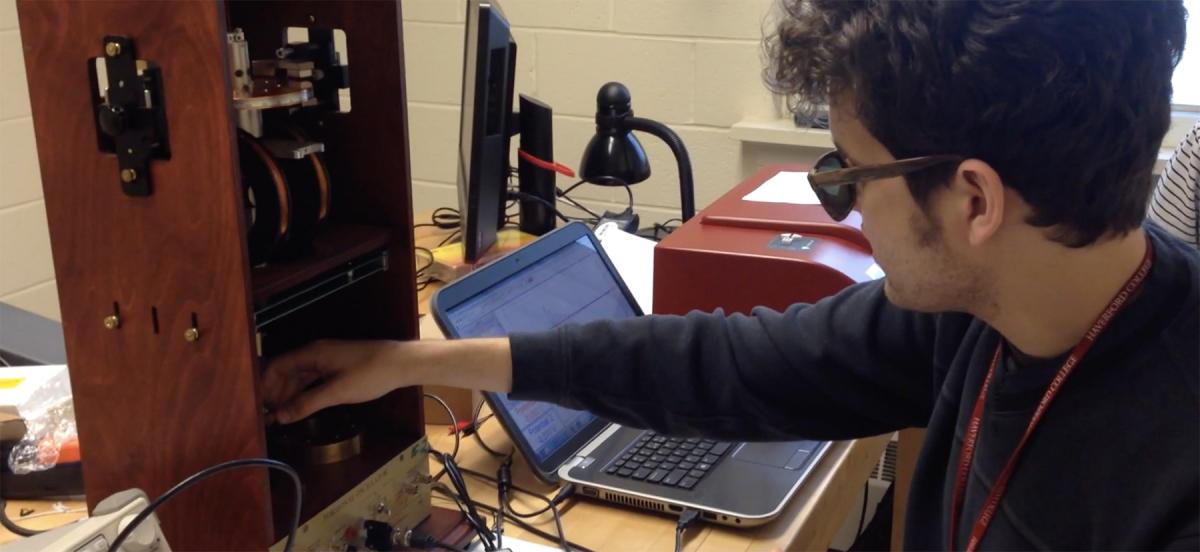Breaking Down Barriers in STEM for Students Who Are Blind or Visually Impaired

Daniel Gillen '17 in the Physics 211 lab at work on a torsional oscillator, aided by sonification equipment. Photo by Visiting Assistant Professor of Physics and Astronomy (and publication co-author) Kevin Setter.
Details
A team of Haverford alumni and professors recently published in the journal The Physics Teacher on methods and resources to help make STEM classrooms more accessible.
The national conversation about making STEM fields more inclusive may be entering mainstream discourse, but for students like Daniel Gillen ’17, who is blind, it remains difficult to find resources aimed at helping educators make their classrooms more accessible for visually impaired students. Gillen’s solution? To develop those resources himself.
In a paper recently published in The Physics Teacher, the physics and music double major and co-authors Megan Holt ’14, Visiting Assistant Professor of Physics and Astronomy Kevin Setter, Physics Laboratory Instructor and Observatory Coordinator Paul Thorman, and Professor of Physics and Astronomy Suzanne Amador Kane aimed to provide provide much-needed advice, methods, and resources for making physics courses accessible for students who are blind or visually impaired.
"When Daniel first arrived at Haverford, we were all surprised and dismayed to learn how little help was out there when we reached out to educators nationwide to learn about current best practices,” said Kane. “Daniel wound up having to be an active player in inventing methods for how to learn physics alongside us as he was learning the actual physics in his courses.”

Drawing on methodology developed by Holt in her senior thesis in physics education at Haverford, Kane and the rest of the physics department worked together with Gillen to dismantle and rework aspects of STEM learning that were previously inaccessible to him.
Traditionally, pedagogical approaches to the physics classroom have been primarily visual, with a focus on complex and abstract theory and concepts. This new paper offers concrete ways of making physics courses more non-visual, emphasizing the importance of incorporating screen-reading software, which converts on-screen content into speech and/or Braille output.
Gillen worked with Setter and Thorman to develop accessible physics laboratory courses, and he and Thorman presented these resources together in an invited talk at the 2018 summer meeting of the American Association of Physics Teachers (AAPT). While the recent publication deals mainly with the work of planning accommodations in the various lecture courses in physics, the co-authors are planning a second publication in which the work presented at the AAPT conference—on lab course accessibility—will feature more prominently.
"What inspired me most to co-author this article was the need for my voice to be heard,” said Gillen. “As a student at Haverford, I have brought about a greater focus on disability rights and awareness in the community, and pioneered and advocated for accessibility tools on campus to assist myself and other community members. It has been important for me to provide clarification on specific parts of my accommodations that the educators leading this effort have gleaned from the collective experience.”

This is not the first time Gillen's name has been in print; in 2014 he co-authored an article for the journal Teaching Linguistics with Assistant Professor of Linguistics Brooke Danielle Lillehaugen, which focuses on creating more accomodating exercises and practices for linguistics students who are blind.
"I find myself endlessly inspired by students and their ability to transform challenges into accomplishments and ways to help others," said Kane. "Not only did Daniel co-author two papers on accessibility and education, he also did his senior thesis on ways to use sound to represent complex datasets in novel and useful ways for all."
Though he does not plan to pursue further academic work in physics, and has developed a passion for urban planning and design since graduation, Gillen remains committed to increasing accessibility for students and other individuals who are visually impaired.
"In whatever field I enter in the future, accessibility will remain a primary focus for me,” he said. “Whether it may be assisting the design of future cities and communities, spreading awareness about Braille and other accessibility tools, or increasing access to STEM subjects, all of these pursuits are all in line with this larger calling of mine.”
Said Kane: "We are all heartened to learn that our work is part of a new national effort in making STEM course more accessible, broadly interpreted beyond our specific context."



